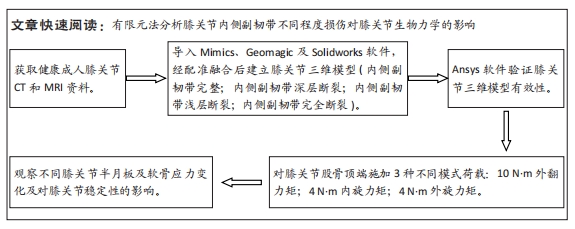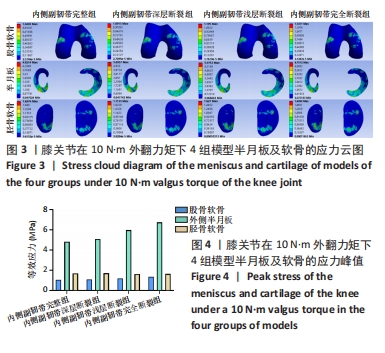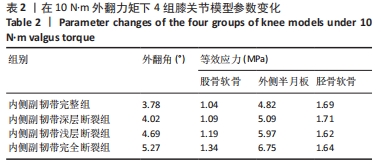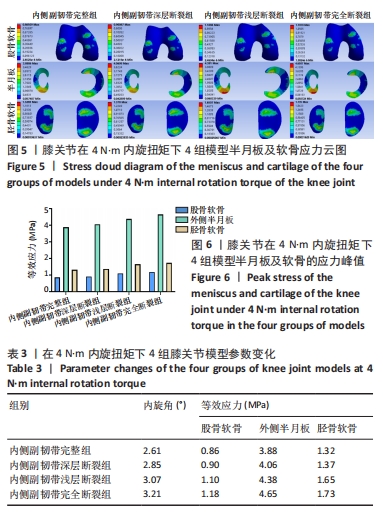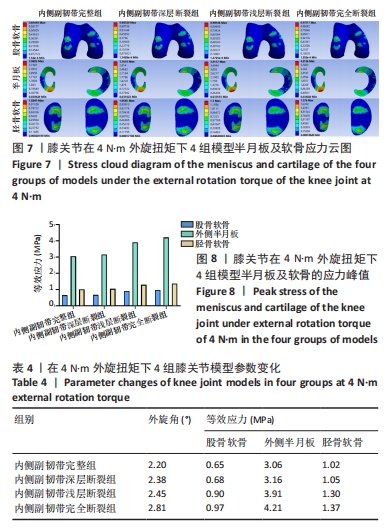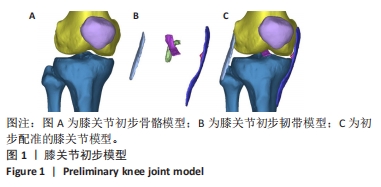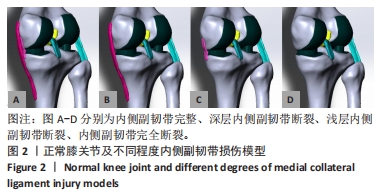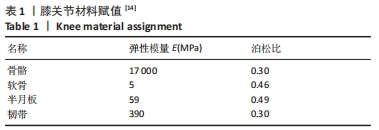[1] WIJDICKS CA, GRIFFITH CJ, JOHANSEN S, et al. Injuries to the Medial Collateral Ligament and Associated Medial Structures of the Knee. J Bone Joint Surg Am. 2010;92(5):1266-1280.
[2] 王海鹏, 王友, 容可, 等. 三维有限元法分析膝关节内侧副韧带的生物力学功能[J]. 医用生物力学,2012,27(1):40-45.
[3] MANCINI EJ, KOHEN R, ESQUIVEL AO, et al. Comparison of ACL Strain in the MCL-Deficient and MCL-Reconstructed Knee During Simulated Landing in a Cadaveric Model. Am J Sports Med. 2017;45(5):1090-1094.
[4] LAPRADE RF, ROBERT F. The Anatomy of the Medial Part of the Knee. J Bone Joint Surg Am. 2007;89(9):2000-2010.
[5] BOLLEN S. Epidemiology of knee injuries: Diagnosis and triage. Br J Sports Med. 2000;34(3):227-228.
[6] 张盼盼. 内侧副韧带断裂损伤对人体自然及TKA后膝关节屈曲运动影响的仿真分析[D]. 焦作:河南理工大学,2017.
[7] REN D, LIU Y, ZHANG X, et al. The evaluation of the role of medial collateral ligament maintaining knee stability by a finite element analysis. J Orthop Surg Res. 2017;12(1):1-10.
[8] BATTAGLIA MJ, LENHOFF MW, EHTESHAMI JR, et al. Medial collateral ligament injuries and subsequent load on the anterior cruciate ligament: a biomechanical evaluation in a cadaveric model. Am J Sports Med. 2009;37(2):305-311.
[9] SHEKARFOROUSH M, BEVERIDGE JE, HART PA, et al. Correlation between translational and rotational kinematic abnormalities and osteoarthritis-like damage in two in vivo sheep injury models. J Biomech. 2018;75:67-76.
[10] GARDINER JC, WEISS JA. Subject-specific finite element analysis of the human medial collateral ligament during valgus knee loading. J Orthop Res. 2010;21(6):1098-1106.
[11] 黄荣瑛, 郑红光, 徐强, 等. MCL缺损对多屈曲角胫股关节力学特性影响[J]. 工程力学,2012,29(7):298-304.
[12] 黄勇, 常崇斐, 苏帆, 等. 膝关节内侧副韧带损伤后对前交叉韧带生物力学的影响[J]. 深圳中西医结合杂志,2020,30(1):194-196.
[13] WILLINGER L, BALENDRA G, PAI V, et al. Medial meniscal ramp lesions in ACL-injured elite athletes are strongly associated with medial collateral ligament injuries and medial tibial bone bruising on MRI. Knee Surg Sports Traumatol Arthrosc. 2022;30(5):1502-1510.
[14] 邵嘉艺, 张家豪, 任爽, 等. 膝关节内侧副韧带浅层(sMCL)止点的解剖学及有限元分析[J]. 中国运动医学杂志,2020,39(2):93-96.
[15] GEESLIN AG, LAPRADE RF. Location of Bone Bruises and Other Osseous Injuries Associated With Acute Grade III Isolated and Combined Posterolateral Knee Injuries. Am J Sports Med. 2010;38(12):2502-2508.
[16] 何川, 李彦林, 张振光, 等. 不同屈曲状态下膝关节韧带生物力学的有限元分析[J]. 中国运动医学杂志,2015,34(7):662-669.
[17] WIERER G, MILINKOVIC D, ROBINSON JR, et al. The superficial medial collateral ligament is the major restraint to anteromedial instability of the knee. Knee Surg Sports Traumatol Arthrosc. 2021;29(2):405-416.
[18] BUCKTHORPE M, PISONI D, T0SARELLI F, et al. Three Main Mechanisms Characterize Medial Collateral Ligament Injuries in Professional Male Soccer-Blow to the Knee, Contact to the Leg or Foot, and Sliding: Video Analysis of 37 Consecutive Injuries. J Orthop Sports Phys Ther. 2021;51(12):611-618.
[19] SIM JA, NA YG, CHOI JW, et al. Early medial reconstruction combined with severely injured medial collateral ligaments can decrease residual medial laxity in anterior cruciate ligament reconstruction. Arch Orthop Trauma Surg. 2022;142(10):2791-2799.
[20] MIYAJI N, HOLTHOF SR, BALL SV, et al. Medial Collateral Ligament Reconstruction for Anteromedial Instability of the Knee: A Biomechanical Study In Vitro. Am J Sports Med. 2022;50(7):1823-1831.
[21] HINTERWIMMER S, BAUMGART R, PLITZ W. Tension changes in the collateral ligaments of a cruciate ligament-deficient knee joint: an experimental biomechanical study. Arch Orthop Trauma Surg. 2002;122(8):454-458.
[22] BREKELMANS WA, POORT HW, SLOOFF TJ. A new method to analyse the mechanical behaviour of skeletal parts. Acta Orthop Scand. 1972;43(5):301-317.
[23] NEWCOMB AG, BAEK S, KELLY BP, et al. Effect of screw position on load transfer in lumbar pedicle screws: a non-idealized finite element analysis. Comput Methods Biomech Biomed Engin. 2017;20(2):182-192.
[24] CHEN YF, LU C, ZHAO Y, et al. Construction and simulation mechanical analysis of dynamic knee joint finite element model based on CT image. Zhongguo Gu Shang. 2020;33(5):479-484.
[25] JOGI SP, THAHA R, RAJAN S, et al. Model for in-vivo estimation of stiffness of tibiofemoral joint using MR imaging and FEM analysis. J Transl Med. 2021;19(1):310.
[26] 王俊然, 杜玮瑾, 王长江, 等. 有限元分析不同屈曲状态下胫-股关节的生物力学变化[J]. 中国组织工程研究,2018,22(31):4975-4981.
[27] 杭声琪, 张文韬, 王泰淇, 等. 基于CT和MRI膝关节有限元模型建立与不同载荷下生物力学特性分析[J]. 中国医学物理学杂志,2021,38(3):370-374.
[28] HWANG SH, JUNG KA, LEE WJ, et al. Morphological changes of the lateral meniscus in end-stage lateral compartment osteoarthritis of the knee. Osteoarthritis Cartilage. 2012;20(2):110-116.
[29] 郑明, 林凤飞, 肖莉莉,等. 膝内、外翻畸形对膝关节影响的三维有限元计算分析[J]. 骨与关节损伤杂志,2004,19(3):174-176.
[30] 单云官, 王连鹏, 张金波,等. 股胫关节面的形态与扣锁机制的解剖学基础[J]. 中国临床解剖学杂志,2007,25(6):650-652+655.
[31] 黄振宇, 董跃福, 胡广洪, 等. 基于有限元方法的正常和早期OA膝关节生物力学行为比较[J]. 中国数字医学,2015,10(5):6-9.
[32] BALL S, STEPHEN JM, EL-DAOU H, et al. The medial ligaments and the ACL restrain anteromedial laxity of the knee. Knee Surg Sports Traumatol Arthrosc. 2020;28(12):3700-3708.
[33] 吴铮,任静,万建杉,等. 步态周期下半月板损伤对膝关节生物力学性能的影响[J]. 中国组织工程研究,2020,24(21):3299-3303.
[34] CAVAIGNAC E, CARPENTIER K, PAILHÉ R, et al. The role of the deep medial collateral ligament in controlling rotational stability of the knee. Knee Surg Sports Traumatol Arthrosc. 2015;23(10):3101-3107.
[35] WHITTAKER JL, LOSCIALE JM, JUHL CB, et al. Risk factors for knee osteoarthritis after traumatic knee injury: a systematic review and meta-analysis of randomised controlled trials and cohort studies for the OPTIKNEE Consensus. Br J Sports Med. 2022;56(24):1406-1421.
[36] BLACK AK, SCHLEPP C, ZAPF M, et al. Technique for Arthroscopically Assisted Superficial and Deep Medial Collateral Ligament-Meniscotibial Ligament Repair With Internal Brace Augmentation. Arthrosc Tech. 2018;7(11):e1215-e1219.
[37] WILLIAMS A, BECKER R, AMIS A. The medial collateral ligament: the neglected ligament. Knee Surg Sports Traumatol Arthrosc. 2020;28(12):3698-3699.
[38] IIZAWA N, MORI A, MAJIMA T, et al. Influence of the Medial Knee Structures on Valgus and Rotatory Stability in Total Knee Arthroplasty. J Arthroplasty. 2016;31(3):688-693.
|
